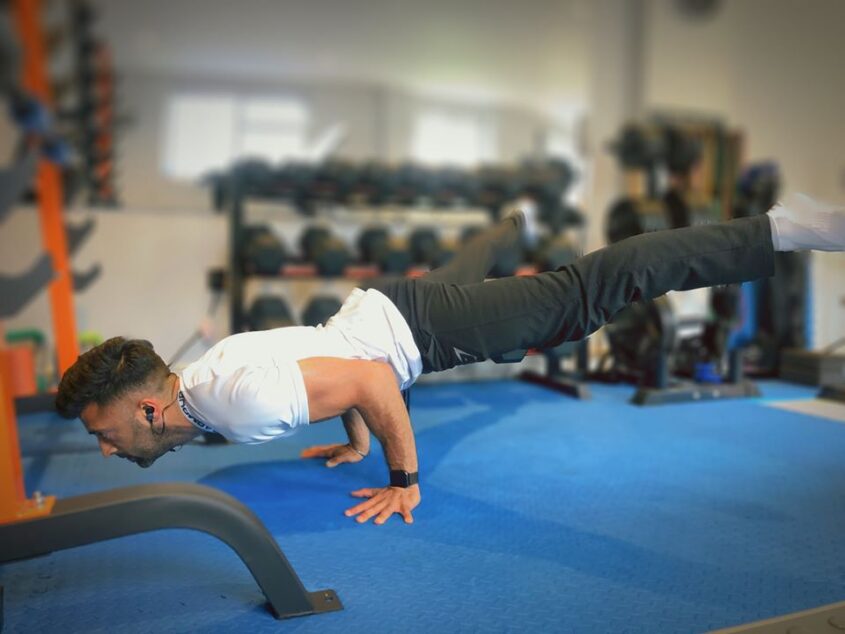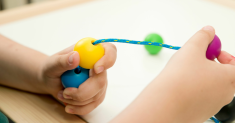Changing how you think is hard. Changing your environment isn’t. By training your environment, your habits follow. We don’t actually think much when we think we’re thinking.
We follow patterns, physical cues that bubble beneath our awareness, and what’s around us. That means our environment powerfully shapes our decisions, more than we realize.
For instance:
Most of us will eat all that we’re served — no matter how big the portion is. If we’re served a small bag of popcorn, we’ll eat that. If we are served a bucket of popcorn, we’ll eat that.
We often eat more when we’re multitasking — Ever started snacking while watching TV or playing video games, then found yourself staring at an empty bag or bowl, wondering where it all went? Your attention was elsewhere, so your eating machine just went on autopilot.
In general, when it comes to engineering healthy eating, here’s the golden rule:
- Make healthy behaviors convenient.
- Make other behaviors less convenient.
Some examples:
- Use smaller plates and cups. Most people eat everything on their plate. Use a smaller plate and you end up eating less naturally.
- If there’s a food you don’t want to eat, avoid keeping it around. Why risk the temptation? Make it less convenient to eat.
- Have fresh, healthy whole foods prepared and in plain sight. Veggies and fruits on your kitchen table or counter; that’s a good start.
- Park your car further away from where you’re going so you have to walk. Those extra steps add up.
- Keep your bike ready to go by the front door. Instead of driving, consider cycling.
- Get a dog that needs walking. Even better, one that will chew up your sofa as punishment if you don’t take it for a daily spin around the block.
People often try to “work hard” to change their habits because changing how you think and feel is hard. But why should everything be so hard, all the time? There’s no need to force it with sheer willpower. You can actually make change much easier by simply changing your environment.
Harness your brain’s autopilot for the side of good:
By just changing what’s around you in small ways, you can make changes without even thinking about them. “Hard work” and “willpower” not required.
15 Ingenious Environment Tweaks that will Improve Your Eating Habits Immediately

1. Keep the Ice-Cream, Cookies, and Chocolates out of the House
Make “laziness” work for you by making it harder and more inconvenient to reach for high-calorie, low-nutrition, easy-to-overeat foods.
If you want sweets, you have to go get them. At 10 PM, when you’re snuggled into your sofa binge-watching your favorite TV show, it’s going to be a lot harder to motivate yourself to get up and go to the grocery store.
Pro tips: Keep a colorful assortment of dried and fresh fruits around for dessert instead.
2. Plan Your Meals
Don’t make fresh decisions every day, or keep meal choices totally open-ended all the time. Instead, take some time and make decisions in advance.
Pro tips: Every few days, plan out the meals you’ll eat for the next few days. Check the list daily so you know:
- What to buy at the grocery store.
- What to pre-prep.
- What meal you’ll eat at what time (or when you’re really hungry).
3. Keep Chopped, ready-to-eat Vegetables in the Fridge
Put them front-and-center so you see them and can get to them easily.
Pro tips: To make your favorite salad veggies even easier, store them “restaurant-style”. Clean and sterilize one of your refrigerator compartments, dump chopped veggies (loose) into it, and cover them with a damp paper towel and a couple of ice cubes.
4. Don’t Be Hungry and in the Grocery Store at the Same Time
Treat food shopping like a surgical operation:
- Have a plan (like your meal list from Tip)
- Get in and get out efficiently. (See if you can make a game of it.)
Pro tips: Focus on the perimeter — the produce, meat, and dairy sections. Don’t even go down the processed food aisles, so you won’t be tempted. Shop with a basket instead of a cart to limit what you can buy (it sneaks in an arm workout, too).
5. Keep Shake Ready Ingredients in the Freezer
Frozen chopped fruit can be dumped straight into the blender and will make your healthy smoothies extra thick and cold.
Pro tips: Are there any greens in your fridge “on their way out”? Stick them in a freezer bag in your freezer. Once frozen, crush them to make flakes. This reduces the space they take up and makes them simple to add to shakes.
6. Keep a Batch of Cooked Grains Handy
Whole grains take time to cook, but if you make a batch on Sunday, you’ll have it in the fridge to use in grain bowls and stir-fries all week long.
Pro tips: Make two batches, and portion one out by the cupful to keep in containers in the freezer. Brown rice reheats nicely in the microwave. It’s like having home-made minute rice on hand.
7. Help Your Kitchen Coach You
Keep your kitchen as clean, pleasant, and clutter-free as possible so you feel relaxed when you enter it (stress = cookie binges). Have an edible plant (like sunflower sprouts) growing on the counter for when you feel like snacking.
Pro tips: Make the fridge door a “vision board” with post-it notes reminding you of your goals, inspiring pictures, and cool looking magnets.
8. Keep Workout Gear in Your Face
Have a kettlebell, resistance bands, a dumbbell or two, a pull-up bar, and/or a suspension trainer in your home or office so you’re more tempted to use them.
Pro tips: Do “trigger training”: Leave the gear in various places throughout your house, and whenever you pass one of them, do a few reps. Over the day this adds up quickly without eating up too much time or leaving you wiped out. Perfect for the busy professional or entrepreneur.
9. Pack Your “Mobile Gym” When You Travel
Book hotels with gyms and/or pools. Pack a jump rope or resistance bands into your suitcase along with a list of bodyweight-only exercises (like squats and pushups) that you can do anywhere.
Pro tips: A small bag of resistance bands is small enough to fit in a carry-on and is incredibly versatile.
10. Turn Your Car into a Locker Room
If you drive a lot, be prepared with gym clothes and a healthy snack so you don’t make counterproductive decisions in desperate moments. Keep a shaker bottle with measured protein powder and greens under the seat — just add water.
Pro tips: Keep a container of several changes in exercise clothes, shoes, and towels in your trunk so you’re ready to move no matter where the day takes you.
11. Schedule Workouts Like You Schedule Meetings
Put them on your calendar and treat them like any other appointment.
Pro tips: Put everything from workouts to laundry, to work meetings, to rest, and recovery on your calendar so that very few things are “unexpected.” Most of our routines are pretty predictable.
12. Move Social Gatherings to Parks and Gyms
It doesn’t always have to be a bar or restaurant. Make your next date outside (frisbee?) or at a climbing gym or trampoline park.
Pro tips: This goes for professional networking, too. Instead of sitting down at a coffee shop, get coffee to go, and have a walking meeting.
13. Combine Walking and Working
Moving while you brainstorm or take a work call helps you focus and avoid the I-sat-at-a-desk-all-day soreness.
Pro tips: Get a used treadmill for a couple of hundred quid off eBay and fit it with a SurfShelf for your laptop. Now you can write, edit, fire off emails…all of it while you walk.
14. Separate Yourself from Your Work Once Per Hour
Work for 50 minutes, then step away from your desk for 10 (may I suggest a walk, some stretches, or some squats?). Cycle this for your workday. You’ll find that you still have energy and focus by the end.
Pro tips: Install anti-RSI software, which “locks” your computer for 5-10 minute intervals every hour so you’re forced to give work a rest.
15. Turn Family and Friends into Coaches
To create a supportive environment, be explicit with loved ones that you’re trying to eat better, and get fit — and why. They don’t have to participate but ask them to help. That takes the pressure off them to do what you’re doing, and most people (especially kids) like “helping” in some way.
Pro tips: Involve your family in goal-related activities, such as menu planning, meal prep, and rep counting. This reduces resistance by giving them ownership, meaning you won’t feel you’re the “other.”
I hope this gives you some ideas on how to stay healthy and active whilst leading a busy life! If you need any other advice, please feel free to comment below 🙂.

















I am really pleased to read this blog posts which consists of tons of useful data, thanks for providing these kinds of statistics.